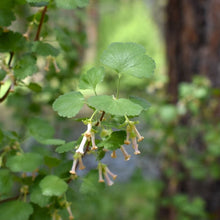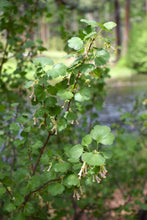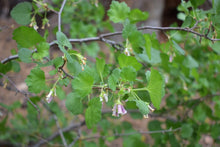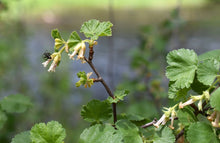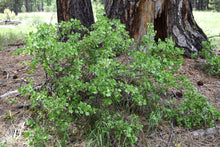
Ribes cereum
Wax currant is a rather compact, deciduous shrub with a rounded form and smooth stout branches that are enveloped in diminutive, light green leaves. Both branches and stems are often studded with fuzzy glands that exude a lightly spicy aroma, hence its “waxy” name. From mid-spring to mid-summer, branches erupt into a profusion of tubular pale pink to white flowers hanging in clusters from the branch tips, beckoning hummingbirds, bees and other insect pollinators. As summer progresses, the flowers are replaced by red-orange berries that are rather tasteless to humans, but highly sought after by birds.
- Plant type/canopy layer: deciduous, perennial, medium shrub
- Size at maturity: 2-6' tall, equally wide
- Light requirements: full sun, part-sun/part-shade
- Moisture requirements: dry soil
- Bloom time: April - July
- Growth rate/ease: fast growing, moderately easy to grow
- Wildlife support: flowers attract and support hummingbirds, butterflies, bees and beneficial insects; fruits attract and support birds; overall plant is believed to host over 80 species of native butterflies and moths
- Native habitat/range: uncommon plant usually found growing along the dry edges of mountain forests, rocky alpine slopes, sagebrush and other high altitude woodlands from British Columbia south to California, eastward to the western Dakotas and the Oklahoma Panhandle. Portland Plant List - no.
- Special features & uses: hummingbird and wildlife magnet; landscape uses include pollinator gardens, hedgerows and screens
Gardening with Wax Currant: This species is relatively easy to grow, when planted in part to full sun areas with dry soil. It prefers sandy or loamy soils with good drainage, rather than clay - but is fairly tolerant of a wide range of soil types. Plant this unique, uncommon shrub on the dry edges of your woodland garden to please pollinators in spring and summer and backyard birds each fall.
Photo Credits 1 - 4, 6: Nikkie West, Sparrowhawk Native Plants
Photo Credit 5: "Ribes cereum 0132" by Walter Siegmund (talk) is licensed under CC BY-SA 4.0.
Photo Credit 7: "File:Wax currant Ribes cereum N of Forester Pass.jpg" by Dcrjsr is licensed under CC BY 3.0.







